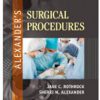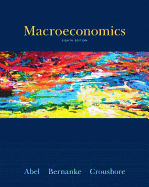Test bank for Macroeconomics 8e by Andrew B. Abel 0133407926
$35.00 Original price was: $35.00.$26.50Current price is: $26.50.
Test bank for Macroeconomics 8e by Andrew B. Abel 0133407926
Test bank for Macroeconomics 8e by Andrew B. Abel 0133407926
Product details:
- ISBN-10 : 0133407926
- ISBN-13 : 978-0133407921
- Author: Andrew B. Abel
Students in this course often struggle to see how the macroeconomic models compare to one another, and fit into the big picture. This text uses a unified approach based on a single economics model that provides students with a clear understanding of macroeconomics and its classical and Keynesian assumptions.
The main objective of the eighth edition is to keep the book fresh and up-to-date, especially in light of the recent crises in the United States and Europe and many new tools used by the Federal Reserve in response to the crisis. To reflect recent events and developments in the field, revisions have been made throughout the text, and additional new applications, boxes, and problems are included.
Description:
1.1 What Macroeconomics Is About
1) The two major reasons for the tremendous growth in output in the U.S. economy over the last 125 years are
A) population growth and low inflation.
B) population growth and increased productivity.
C) low unemployment and low inflation.
D) low inflation and low trade deficits.
Answer: B
Diff: 1
Topic: Section: 1.1
Question Status: Previous Edition
2) The main reason that the United States has such a high standard of living is
A) low unemployment.
B) high average labor productivity.
C) low inflation.
D) high government budget deficits.
Answer: B
Diff: 1
Topic: Section: 1.1
Question Status: Previous Edition
3) Average labor productivity is the
A) amount of workers per machine.
B) amount of machines per worker.
C) ratio of employed to unemployed workers.
D) amount of output per worker.
Answer: D
Diff: 1
Topic: Section: 1.1
Question Status: Previous Edition
4) In analyzing macroeconomic data during the past year, you have discovered that average labor productivity fell, but total output increased. What was most likely to have caused this?
A) There is nothing unusual in this outcome because this is what normally occurs.
B) The capital/output ratio probably rose.
C) There was an increase in labor input.
D) Unemployment probably increased.
Answer: C
Diff: 2
Topic: Section: 1.1
Question Status: Previous Edition
5) In which of the following periods did average labor productivity in the United States grow the fastest?
A) 1929 to 1935
B) 1949 to 1973
C) 1973 to 1995
D) 1995 to 2008
Answer: B
Diff: 1
Topic: Section: 1.1
Question Status: Previous Edition
6) The most direct effect of an increase in the growth rate of average labor productivity would be an increase in
A) the inflation rate.
B) the unemployment rate.
C) the long-run economic growth rate.
D) imported goods.
Answer: C
Diff: 1
Topic: Section: 1.1
Question Status: Previous Edition
7) Short-run contractions and expansions in economic activity are called
A) recessions.
B) expansions.
C) deficits.
D) the business cycle.
Answer: D
Diff: 1
Topic: Section: 1.1
Question Status: Previous Edition
8) When national output rises, the economy is said to be in
A) an expansion.
B) a deflation.
C) an inflation.
D) a recession.
Answer: A
Diff: 1
Topic: Section: 1.1
Question Status: Previous Edition
9) Which of the following best describes a typical business cycle?
A) Economic expansions are followed by economic contractions.
B) Inflation is followed by unemployment.
C) Trade surpluses are followed by trade deficits.
D) Stagflation is followed by inflationary economic growth.
Answer: A
Diff: 1
Topic: Section: 1.1
Question Status: Previous Edition
10) During recessions, the unemployment rate ________ and output ________.
A) rises; falls
B) rises; rises
C) falls; rises
D) falls; falls
Answer: A
Diff: 1
Topic: Section: 1.1
Question Status: Previous Edition
11) The number of unemployed divided by the labor force equals
A) the inflation rate.
B) the labor force participation rate.
C) the unemployment rate.
D) the misery index.
Answer: C
Diff: 1
Topic: Section: 1.1
Question Status: Previous Edition
12) The unemployment rate is the
A) number of unemployed divided by the number of employed.
B) number of employed divided by the number of unemployed.
C) number of unemployed divided by the labor force.
D) labor force divided by the number of unemployed.
Answer: C
Diff: 1
Topic: Section: 1.1
Question Status: Previous Edition
13) The highest and most prolonged period of unemployment in the United States over the last 125 years occurred during
A) World War II.
B) the 1890s Depression.
C) the 1990-1991 recession.
D) the Great Depression of the 1930s.
Answer: D
Diff: 1
Topic: Section: 1.1
Question Status: Previous Edition
14) During the Great Depression, the unemployment rate for the United States peaked at approximately
A) 10%.
B) 70%.
C) 45%.
D) 25%.
Answer: D
Diff: 2
Topic: Section: 1.1
Question Status: Previous Edition
15) A country is said to be experiencing inflation when
A) prices of most goods and services are rising over time.
B) prices of most goods and services are falling over time.
C) total output is rising over time.
D) total output is falling over time.
Answer: A
Diff: 1
Topic: Section: 1.1
Question Status: Previous Edition
16) From 1800 to 1940, the price level in the United States
A) trended neither upward nor downward.
B) fluctuated wildly.
C) declined slowly.
D) increased slowly.
Answer: A
Diff: 2
Topic: Section: 1.1
Question Status: Previous Edition
17) Before World War II, the average level of prices in the United States usually
A) fell during wartime and rose during peacetime.
B) fell during wartime and fell during peacetime.
C) rose during wartime and fell during peacetime.
D) rose during wartime and rose during peacetime.
Answer: C
Diff: 1
Topic: Section: 1.1
Question Status: Previous Edition
18) A country is said to be experiencing deflation when
A) prices of most goods and services are rising over time.
B) prices of most goods and services are falling over time.
C) total output is rising over time.
D) total output is falling over time.
Answer: B
Diff: 1
Topic: Section: 1.1
Question Status: Previous Edition
19) The inflation rate is the
A) percent increase in the average level of prices over a year.
B) percent increase in output over a year.
C) percent increase in the unemployment rate over a year.
D) price level divided by the level of output.
Answer: A
Diff: 1
Topic: Section: 1.1
Question Status: Previous Edition
20) If the price level was 100 in 2009 and 102 in 2010, the inflation rate was
A) 102%.
B) 20%.
C) 2%.
D) 0.2%.
Answer: C
Diff: 2
Topic: Section: 1.1
Question Status: Previous Edition
21) A closed economy is a national economy that
A) doesn’t interact economically with the rest of the world.
B) has a stock market that is not open to traders from outside the country.
C) has extensive trading and financial relationships with other national economies.
D) has not established diplomatic relations with other national economies.
Answer: A
Diff: 1
Topic: Section: 1.1
Question Status: Previous Edition
22) An open economy is a national economy that
A) doesn’t interact economically with the rest of the world.
B) has a stock market that is open to traders from anywhere in the world.
C) has extensive trading and financial relationships with other national economies.
D) has established diplomatic relations with most other national economies.
Answer: C
Diff: 1
Topic: Section: 1.1
Question Status: Previous Edition
23) An economy that doesn’t interact economically with the rest of the world is called ________ economy.
A) a closed
B) an open
C) a surplus
D) an authoritarian
Answer: A
Diff: 1
Topic: Section: 1.1
Question Status: Previous Edition
24) U.S. imports are goods and services
A) produced abroad and sold to Americans.
B) produced in the United States and sold to Americans.
C) produced abroad and sold to foreigners.
D) produced in the United States and sold to foreigners.
Answer: A
Diff: 1
Topic: Section: 1.1
Question Status: Previous Edition
25) Following World War I and World War II, the United States had a
A) small trade surplus.
B) small trade deficit.
C) large trade deficit.
D) large trade surplus.
Answer: D
Diff: 1
Topic: Section: 1.1
Question Status: Previous Edition
26) In the 1980s, 1990s, and 2000s, the United States has had a
A) small trade surplus.
B) small trade deficit.
C) large trade deficit.
D) large trade surplus.
Answer: C
Diff: 1
Topic: Section: 1.1
Question Status: Previous Edition
27) A country has a trade surplus when
A) imports exceed exports.
B) imports equal exports.
C) exports exceed imports.
D) imports equal zero.
Answer: C
Diff: 1
Topic: Section: 1.1
Question Status: Previous Edition
28) A country has a trade deficit when
A) imports exceed exports.
B) imports equal exports.
C) exports exceed imports.
D) exports are zero.
Answer: A
Diff: 1
Topic: Section: 1.1
Question Status: Previous Edition
29) Data on exports and imports for the United States over the period from 1890 to 2008 show that
A) the United States had large trade deficits throughout this entire period.
B) the United States had large trade surpluses throughout this entire period.
C) the percentage of total output exported by U.S. firms fell dramatically during World War I and World War II.
D) a higher percentage of U.S. goods was exported in recent years than in earlier years.
Answer: D
Diff: 2
Topic: Section: 1.1
Question Status: Previous Edition
30) A central bank is an institution that
A) pays for government expenditures.
B) controls a nation’s monetary policy.
C) runs a country’s stock market.
D) determines a nation’s fiscal policy.
Answer: B
Diff: 1
Topic: Section: 1.1
Question Status: Previous Edition
31) In the United States, monetary policy is determined by
A) the Federal Reserve.
B) the president.
C) private citizens.
D) the Treasury Department.
Answer: A
Diff: 1
Topic: Section: 1.1
Question Status: Previous Edition
32) The peak in U.S. government spending as a percent of GDP occurred during
A) World War II.
B) the 1960s war on poverty.
C) the Great Depression.
D) the war against Iraq in the 2000s.
Answer: A
Diff: 1
Topic: Section: 1.1
Question Status: Previous Edition
33) Why were the U.S. government budget deficits of the 1980s and early 1990s so unusual from a historical point of view?
A) It was the first time the U.S. government had ever run deficits.
B) In the past, deficits were usually that large only in wartime.
C) It was the first time that deficits were accompanied by very high rates of inflation.
D) It was the first time that deficits diverted funds from other productive uses, such as investment in modern equipment.
Answer: B
Diff: 1
Topic: Section: 1.1
Question Status: Previous Edition
34) Critics of the government’s fiscal policies argued that government deficits
A) prevented capital from flowing into the United States.
B) were linked to the excess of imports over exports that occurred in the 1980s.
C) caused the level of unemployment in the United States to increase during the 1980s.
D) had directly contributed to a decline in the level of demand in the American economy.
Answer: B
Diff: 2
Topic: Section: 1.1
Question Status: Previous Edition
35) The difference between microeconomics and macroeconomics is that
A) microeconomics looks at supply and demand for goods, macroeconomics looks at supply and demand for services.
B) microeconomics looks at prices, macroeconomics looks at inflation.
C) microeconomics looks at individual consumers, macroeconomics looks at national totals.
D) microeconomics looks at national issues, macroeconomics looks at global issues.
Answer: C
Diff: 1
Topic: Section: 1.1
Question Status: Previous Edition
36) Aggregation is the process of
A) calculating real GDP based on nominal GDP and the price index.
B) summing individual economic variables to obtain economywide totals.
C) forecasting the components of GDP.
D) predicting when recessions will occur.
Answer: B
Diff: 1
Topic: Section: 1.1
Question Status: Previous Edition
People also search:
principles of macroeconomics 8th edition
macroeconomics 8th edition hubbard
principles of macroeconomics 8th canadian edition
mankiw macroeconomics 8th edition
hubbard and o’brien macroeconomics 8th edition
olivier blanchard macroeconomics 8th edition
macroeconomics 8th edition hubbard and o’brien












